Bark pealing was a traditional practice amongst the Sami people of northern Scandinavia and of many different indigenous tribes of North America. Some researchers argue if the bark was used as a common food in their diet or just used in a dire starvation survival situations. One can even find visual evidence of the bark peeling practice in old growth forests in Europe and North America. Many different species of pines were used in harvesting. The cambium layer in pine bark contains carbohydrates, minerals and vitamin C.
With a recent storm that blew through, the top half of one the pines that shares our land broke off. Thanking the tree for not falling on our house, I wanted to think up ways to respect it. Lately, with all the learning and research of the plants that grow around my home, I want to make sure that we are respecting them and using them in a sustainable way. What a perfect opportunity to learn about eastern white pine bark flour making. Also a great time to harvest some needles, and resin for medicine.
Related: How Our Forefathers Made Glue Out of Pine Resin
Always appreciate the pine. It offers so much. Food, medicine, shelter, fire and tools. From the floors you walk on in your home, and maybe to the table you gather around with your friends and family near. All the ancestors who lived these lands before us knew the great pine and appreciated it well.
The Peeling and Drying Process
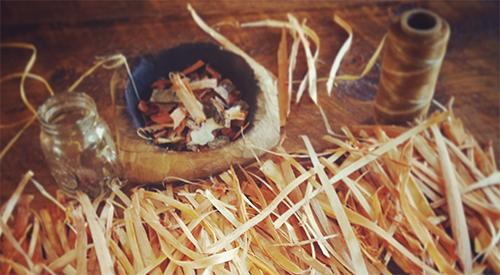
Log after log I would scrap the resin into a tiny glass jar (infuse in olive oil for salve). Peal the bark away with a butter knife and separate the Cambium layer from the outer bark.
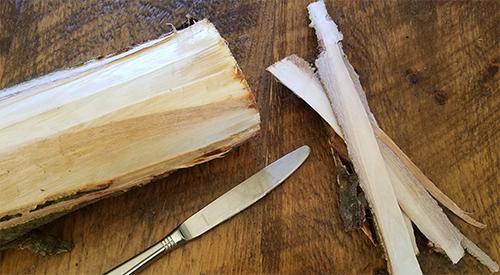
Don’t forget to save some bark for medicinal teas. I tied the bark into bundles to hang dry and wait to few day. It dries out pretty fast.
One can also use the oven on a very low temp checking for dryness every 10 to 15 minutes. This makes your house smell amazing.
The Flour Process
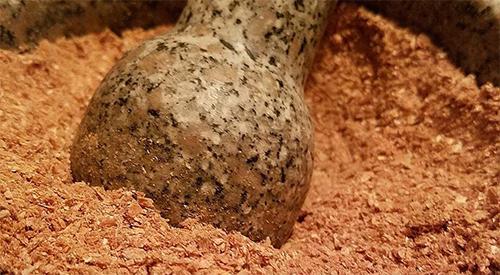
Bark strips should be brittle. Break in half easily. Break into small pieces and grind with a mortar and pestle or use the blender. A blender will save you time. Make sure that the bark is ground into a powder consistency. Or when consuming you may get a rough piece of bark to chew through. Keep in a container or mason jar for later use. You can add the bark flour into any baking recipes of choice. Just make sure you still use flour of your choice. It will give your breads, cookies and cakes a hint of pine flavor for sure. As I experiment more I will add more and update recipes.
Pine Bark Honey Shortbread
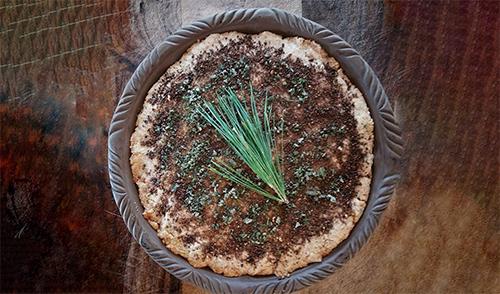
- 1 Cup Butter
- 2 Cups All-Purpose Flour
- 1/2 Cup Pine Bark Flour
- 1/3 Cup Honey
- ¾ Cup Ground Acorn 1 tsp. Vanilla (optional)
Mix butter and honey and vanilla until fluffy. Add flour, a little at a time, add in the acorn. Press dough into shortbread mold or ungreased cast iron skillet. Bake in preheated 300F oven 35 to 40 minutes.
Enjoy warm!
Editor’s note: This article was gladly contributed by Caroline and first appeared on backyardrewilding.wordpress.com.
You may also like:
 The Map That Shows You The Edible Trees In Your Neighborhood
The Map That Shows You The Edible Trees In Your Neighborhood
10 Things Cowboys Carried With Them in the Wild West to Survive (Video)
How to Make Candles out of Pine Resin (With Pictures)
This Tree Is Like Bread But You Can Only Harvest It In The Next 3 Months

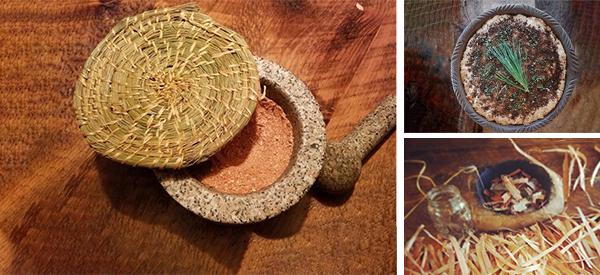















I’ve heard you can fry strips of cambium and eat it like bacon with eggs and toast.
This is too funny! I was looking in my inbox at subjects, and saw pine flour bark! I said to myself, ”I need to post something about this on Claude’s website, so everybody will know! THEN I looked and saw it was FROM his website! I started laughing my booty off!
Totally off topic, but a lot of people here are interested in alternative healing, so I have to post this. A friend of ours was diagnosed with stage 4 lung cancer a year ago, I was just up in Oklahoma visiting him and admiring how a person who was supposed to be dead and gone 6 months ago was happily (though still moving kinda slow) cutting down trees, chainsawing the trunks to firewood length, splitting and stacking firewood. He had had good enough insurance to have good standard care but he had also supplemented with vitamins, curcumin, and a dog wormer called fenbendazole. Here is a link to the website of Joe Tippens who is trying to get word out about this treatment which saved my friend. It’s pretty cool.
https://www.mycancerstory.rocks/single-post/2016/08/22/Shake-up-your-life-how-to-change-your-own-perspective
Wish I could have read his story. Hope he’s still with us. Apparently the page has been removed.
I’m a little confused, Kyle. In the first part of the article you say to separate the cambium from the bark itself. When you describe the flour process you say to take actual strips of bark and grind them into a fine powder. Are we eating just the ground up cambium or the bark itself with the cambium attached? I really wouldn’t think pine bark itself would be so good for us to eat. That’s a heck of a lot of fibre. And we still have to use regular flour. In a true survival situation we might not have a lot of wheat flour on hand. Sounds to me like you’re using what’s on hand (pine bark?) to make the regular flour last longer. We may as well grind up wood chips to achieve the same end.
Hello, Armin.
It might be a misunderstanding due to the fact that the author is saying ‘bark strips’ but it is not referring to it as the outer or inner bark, but the cambium layer. If you dry the cambium it will become brittle and you can blend it.
You can mix the cambium flour with regular flour, but you can also use by itself, if you have enough material that is.
Do your research before because not all pine trees have edible cambium and some are toxic for human consumption.
I like pine as a medicinal. But, donno about this one. Anything in the pine family has toxins like tannin. That causes protein to be lost and abortions, as well. In winter men would eat spruce buds to stave off a vitamin C deficiency (scurvy) (and still do, they taste like strawberries). Children and old women, as well, but not women of childbearing age. Instead, they made wine by barrel. But, bark flour from poplar trees (10% protein), maples, and something else are all good. It was the only time anyone under 40 was allowed alcohol.
cambium bark, armin! It’s Christmas Eve. busting stones on Christmas Eve means a load of reindeer pellets in your pellet burner–do you know how bad fresh deer pellets smell when burned? 🙂 niio!
There’s 2 videos I’ve seen on You Tube where they talk about this and eat it too. Thumbs Up. i Like OLE!
The point of survival food sources is to get more food value from a source than you expend in energy harvesting and preparing the food. There are many things eatable, not so many sources that are worth the expenditure of energy and time.
True, very true, but when things quiet down some, how much time will you have? No job but to gather food, watch for zombies and creepy-crawlies (those driven insane to extreme stupidity and hate). As the latter two die off, this is going to be your work, gather food, make weapons and tools, and hunt for them, as well. That’s your job description, hunter-gatherer. Funny thing, I looked forward to this for decades, we always understood what man builds, man destroys, including nations. Yet, it’s come so late in my life… 🙂 niio
Eating pine bark was started in the Americas, and when a fairly famous voyage came across to the new world, from Europe – a lot of them had gotten sick (with what later became known as scurvy). The natives showed the travelers how to prepare stews out of the bark, and it healed all the sick. They then returned to Europe with this knowledge. As well as several species of conifer, to bring the new medicine back home.
I read a really good article about it, fairly recently.
Is this for a large or small cast iron skillet. Also can I use maple syrup instead of honey?